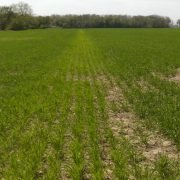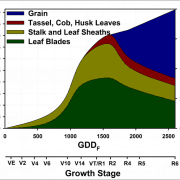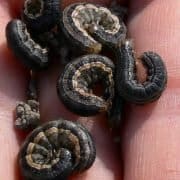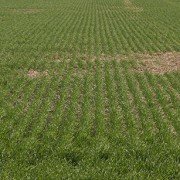Managing bare areas in winter wheat stands
By Joanna Folings, Cereal Specialist
How should one deal with large bare spots in a wheat field that is otherwise in good condition? Unfortunately, there isn’t a one size fits all solution because the size and number of bare spots in fields greatly varies. Here are some options and considerations for filling in those bare spots.
Leave the bare spots alone
While doing nothing with the bare spots may seem like the easiest option, it may create headaches later on. The biggest implication is weeds. If you decide to leave the bare spots alone, at minimum you should consider a herbicide application to those areas to keep weeds under control. Glyphosate resistant Canada fleabane can produce up to one million seeds per plant, so even one Canada fleabane escape can have implications down the road. Leaving the soil completely bare and exposed leaves it prone to soil erosion and is a missed opportunity for a clover cover crop. Canada fleabane is best controlled with herbicides when they are applied prior to bolting so make sure to monitor its growth regularly.
Seed a clover cover crop
Red clover has been shown to provide excellent benefits in terms of soil health and provides a nitrogen credit to the following crop. Seeding red clover into bare areas covers the soil and protects it from erosion. It also helps keep weeds under control. One thing to keep in mind is that the clover will likely grow well in those spots and may be a challenge during winter wheat harvest. If you decide to move forward with seeding red clover into the bare areas, you may want to use a single cut clover rather than a double cut clover. The single cut will result in less top growth making harvest through those areas easier and will also help with avoiding any extra green material in the straw. Additionally, this option does not require you to avoid harvesting through a particular area and the need to keep keeping grains separate is not a concern.
Seed a spring cereal (oats, barley or spring wheat)
Similar to red clover, seeding a spring cereal such as oats, barley or spring wheat keeps the soil covered and helps with weed competition. It will also provide the added benefit of additional straw. However, there are a few challenges with choosing this option.
Oats and Barley: The nitrogen requirements of oats and barley is different than the nitrogen requirements of winter wheat. If you manage the field as a whole and are applying higher rates of nitrogen to your wheat crop it may cause lodging issues in the oats and barely. This has implications at harvest and you may not be able to adequately harvest those crops and get all the straw as originally intended. You will also need to work around these areas at harvest which may bring challenges if you are hiring a custom operator or are trying to row straw for harvest.
Spring Wheat: If you are considering seeding spring wheat into these areas it needs to be done soon! The optimum seeding window for spring cereals closing fast for some areas. The bare areas tend to be wettest areas of the field and may be weeks away from being suitable for a drill to go through. If spring wheat seeding is pushed to late in the season chances are you will be disappointed with the crop.
It is also important to remember that you cannot mix your spring wheat and winter wheat at harvest. If you mix the two crops your wheat will be marketed as feed and will not be graded and marketed as the class of winter wheat you have grown (i.e. soft red, hard red, soft white). You can only harvest or mix the two crops together if you are keeping if for feed. The spring wheat will be at a different stage than your winter wheat so management for fusarium head blight in those spots may be difficult. Selecting a moderately resistant spring wheat variety is recommended.
Seeding a spring cereal into bare spots is best suited for very large areas in fields where a grower has the ability to easily work around those areas and keep them separate. It is also only really recommended when a grower is in need of straw.
Seed winter wheat
Seeding winter wheat into the bare spots again provides a cover for the soil and helps with weed competition. However, seeding winter wheat in the spring means that the wheat will not vernalize and will not produce seed. Therefore, you will not be able to get the same straw harvest that you would from planting a spring cereal in those spots.
Create a field within a field
Another option is to spray out the worst area of field if it can be consolidated to a mini-field. This option allows you to keep the good part of your winter wheat stand and manage it to its full yield potential without the hassle of working around certain areas. The area you spray out can then go to corn or soybeans.
The key to managing these bare areas is to work through all the options available to you and how it best fits the needs of your operation not only for the crop but the workload as well. Have a plan in place before going out to the field. You don’t want to fill your drill then go out to the field and find yourself driving all over and trying to fill in every bare spot in the field. Target those spots that are large and are more prone to erosion and weed escapes.









